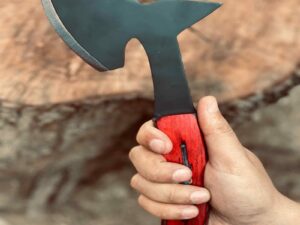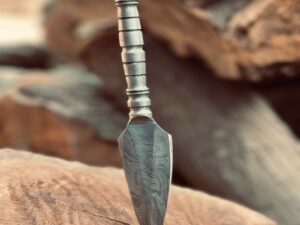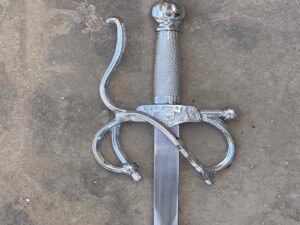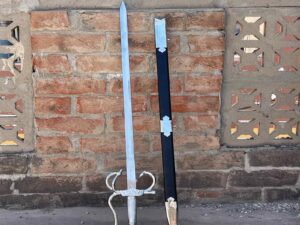The Vikings, seafaring Norse people from Scandinavia who lived from the late 8th to early 11th centuries, gained renown for their prowess in warfare and exploration. Their weapons were not only crucial in their raids and battles but also reflected their technological ingenuity and cultural values. This article explores the primary weapons used by the Vikings, highlighting their construction, uses, and significance in Viking society.
Swords – A Symbol of Warrior-hood
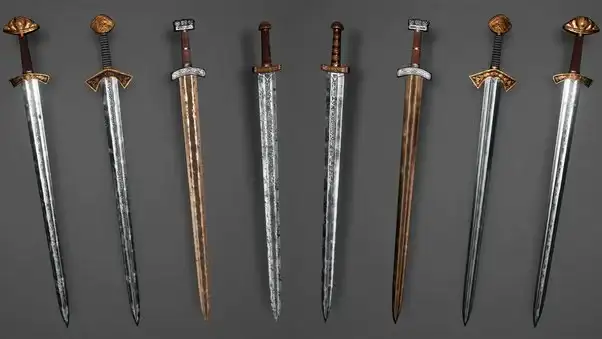
Design and Construction: Viking swords were a symbol of status and power. Typically, they had double-edged blades ranging from 70 to 90 centimeters in length. Craftsmen made the blade from high-quality iron, often using the pattern-welding technique, which involved twisting strips of iron and steel together to create a strong, flexible blade with a distinctive pattern.
Features: Viking swords had a distinct cross guard and a rounded pommel, which helped balance the sword and offered a better grip. The hilt was often richly decorated, with intricate designs or inlays, reflecting the owner’s wealth and status.
Uses: Swords were versatile weapons used for both slashing and thrusting. Viking warriors of higher social status primarily wielded them, as they were expensive to make and maintain.
Axes – A Versatile Weapon
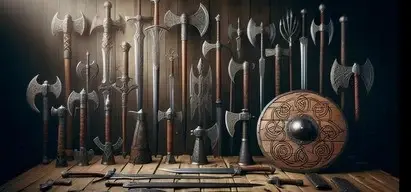
Design and Construction: Viking axes came in various forms, from the small hand axes used for everyday tasks to large battle axes. The most iconic Viking axe is the “bearded axe,” characterized by its extended, curved blade and prominent beard-like projection.
Features: The bearded axe’s design allowed for powerful, cleaving strikes and effective use in close combat. The blade was often attached to a long wooden handle, which could vary in length depending on the type of axe and its intended use.
Uses: Axes were versatile tools and weapons used for chopping wood as well as in combat. In battle, they could deliver devastating blows, with the bearded axe allowing for both powerful strikes and grappling techniques.
Spears – A Primary Weapon
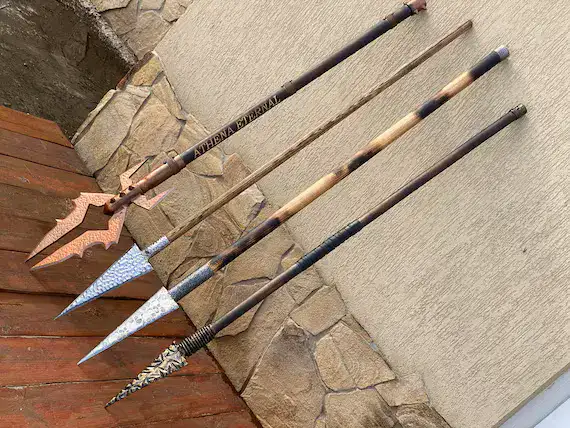
Design and Construction: Spears were a common weapon for Viking warriors and came in various sizes and forms. The spearhead was typically made of iron, and the shaft was usually about 1.8 to 2.4 meters long.
Features: The spear’s design allowed for both thrusting and throwing. The spearhead often featured a leaf-shaped or triangular design optimized to penetrate armor and shields. Decorative elements or inscriptions sometimes adorned the spears.
Uses: Spears were versatile and could be used in hand-to-hand combat or thrown at enemies from a distance. They were a preferred weapon for many Vikings due to their effectiveness in both offensive and defensive situations.
Shields – A Defensive Necessity
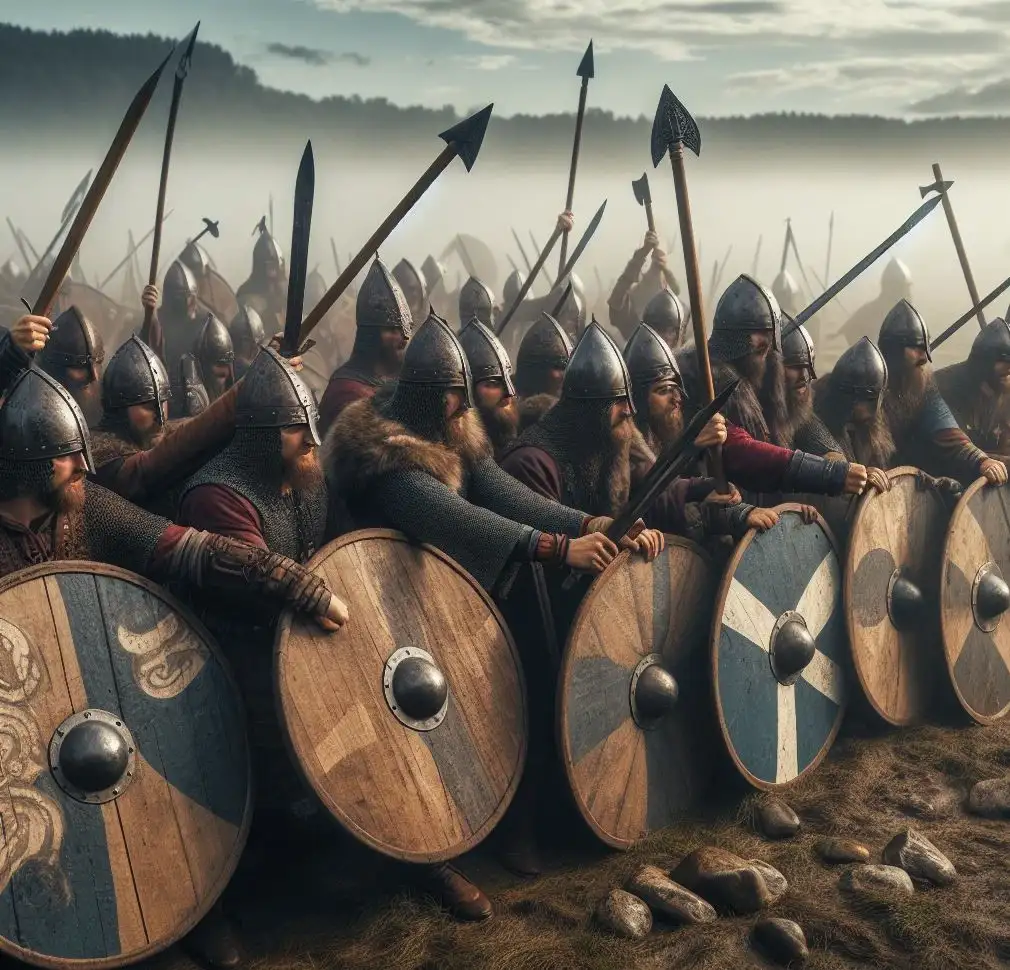
Design and Construction: Viking shields were round, typically around 90 centimeters in diameter, and made from wood, with a metal boss in the center. The wooden planks were often reinforced with metal rims or bands to enhance durability.
Features: The shield’s boss (central metal knob) protected the hand and doubled as an offensive weapon in combat. Warriors often painted shields with intricate designs or symbols, adding both practical and symbolic significance.
Uses: Shields were crucial for defense, protecting against enemy blows and missile attacks. In battle, they were used in shield walls, a defensive formation that was a hallmark of Viking combat tactics.
Bows and Arrows
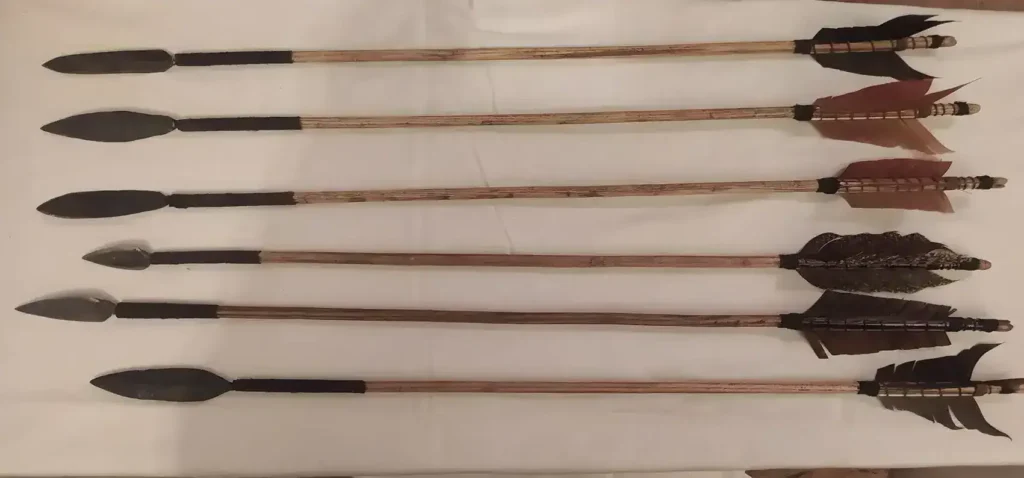
Design and Construction: Vikings used bows and arrows, particularly for hunting and skirmishing, though these weapons were less prominent than melee weapons. They typically crafted bows from wood and fitted arrows with iron or bone tips.
Features: Viking bows were relatively short and suited to the mobile and dynamic nature of Viking warfare. The arrows were often fletched with feathers and tipped with a variety of points for different purposes, such as hunting or combat.
Uses: Bows and arrows allowed Vikings to engage enemies from a distance and were especially useful in raids or naval battles. Archery complemented their primary tactics and added versatility to their combat strategies.
Daggers
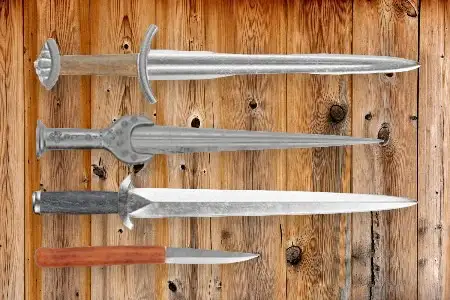
Design and Construction: Vikings crafted daggers, known as “seax,” as single-edged knives used for various purposes. They often carried these knives, with blade lengths ranging from 10 to 30 centimeters, as secondary weapons or utility tools.
Features: The seax had a broad, straight blade and a simple hilt, making it practical for close combat or as a utility tool. Some seaxes had decorative elements, but they were generally utilitarian.
Uses: People used daggers in close-quarters combat, as tools, and for everyday tasks. They were a practical complement to larger weapons and essential for personal defense.
Other Weapons

In addition to the weapons mentioned above, Vikings also used a variety of other weapons, including:
- Knives: Vikings used knives for a variety of tasks, including hunting, cooking, and personal hygiene.
-
Clubs and maces often served as weapons for infantry soldiers or for those who could not afford swords or axes
Significance and Legacy
The weapons used by the Vikings were not just tools of war but also symbols of their identity, status, and craftsmanship. Each weapon type reflected a specific aspect of Viking culture, from the craftsmanship of swords to the tactical use of spears and shields. The legacy of Viking weaponry is evident in the numerous archaeological finds and historical accounts that illustrate their impact on medieval warfare and society.
Conclusion
Viking weapons were a testament to their technological prowess and martial skill. From the iconic swords and axes to the versatile spears and bows, these weapons played a crucial role in shaping the Viking Age and its legacy in history.

